Today film historian Ivo Blom gives a paper in Rome on painter Lawrence Alma-Tadema and the Italian antiquity film Fabiola (Enrico Guazzoni, 1918), featuring Elena Sangro. Blom will focus on mise-en-scene, especially props and deep staging. The organisers of the event are the German Archaeological Institute, the Austrian Archaeological Institute, and the Cineteca Nazionale. Of course EFSP joins the fun with a post on this silent film.
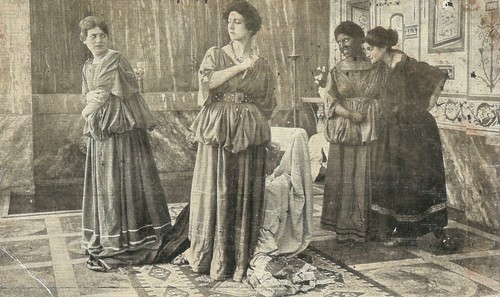
Spanish postcard for Amatller Marca Luna chocolate. Series 8, no. 1. Photo: Palatino Film. Elena Sangro as Fabiola in Fabiola (Enrico Guazzoni, 1918). When her servant accidentally hurts her with a hairpin, the rich and cruel aristocrat Fabiola hurts her slave with a sharp weapon Roman ladies used to have for these matters. This is from the opening scene of the film.
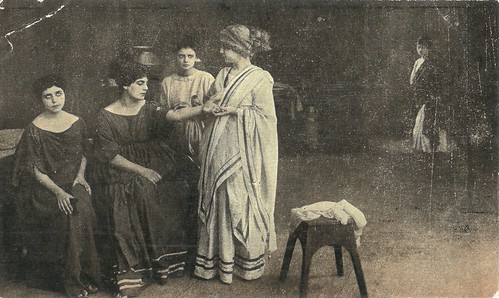
Spanish postcard for Amatller Marca Luna chocolate. Series 8, no. 3. Photo: Palatino Film. Publicity still for Fabiola (Enrico Guazzoni, 1918). Agnese (sig.a Poletti) tends to the wound of Syrta, afflicted by Fabiola's stiletto.
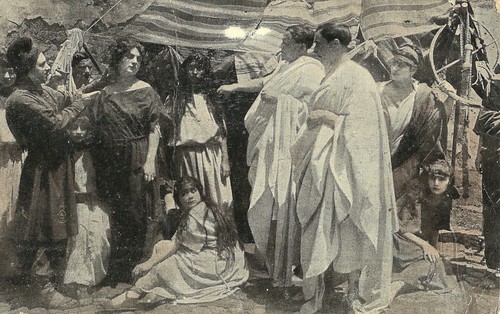
Spanish postcard for Amatller Marca Luna chocolate. Series 8, no. 6. Photo: Palatino Film. Publicity still for Fabiola (Enrico Guazzoni, 1918). Fulvio remembers how his sister Syra was sold as a slave when she was discovered to be a Christian. He discovers she is in the household of Fabiola.
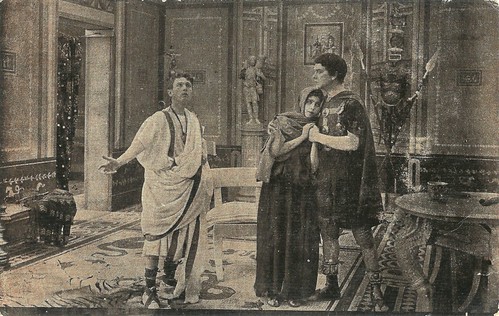
Spanish postcard for Amatller Marca Luna chocolate. Series 8, no. 14. Photo: Palatino Film. Livio Pavanelli as St. Sebastiano in Fabiola (Enrico Guazzoni, 1918), hosting the blind Cecilia on request of the young Pancrazio.

Spanish postcard for Amatller Marca Luna chocolate. Series 8, no. 12. Photo: Palatino Film. Publicity still for Fabiola (Enrico Guazzoni, 1918). Sebastiano (Livio Pavanelli) chases the intruder Fulvio (Amleto Novelli) from Agnese's house.
The Italian historical film Fabiola (Enrico Guazzoni, 1918) stars Elena Sangro as Fabiola, Augusto Mastripietri as Eurota, Amleto Novelli as Fulvio, and Livio Pavanelli as San Sebastiano. The secondary role of Quadrato was played by the famous 'forzuto' Bruto Castellani, very popular at the time as the strongman Ursus from Quo vadis? (Enrico Guazzoni, 1913).
The Palatino Film production is an adaptation of the 1854 novel Fabiola by Cardinal Nicholas Patrick Wiseman. The story is set in Rome in the early 4th century AD, during the time of the persecution of Christians under the Roman Emperor Diocletian.
The heroine of both book and film is Fabiola, a young beauty from a noble Roman family. She is spoiled by her father Fabius, who cannot deny her anything. Fabiola seems to have everything, including a superior education in the philosophers, yet under the surface, she is not content with her life.
One day, in a fit of rage, she attacks and wounds her slave girl Syra, who is secretly a Christian. The proud, spoiled Roman girl is humbled by Syra's humility, maturity and devotion to her in this situation, and a slow transformation begins, which finally culminates in her conversion to Christianity, brought on by her own cousin Agnes, whom she adores and dotes on.
Another thread of the novel deals with the young boy Pancratius (in the film called Pancrazio), a pious Christian and son of a martyr, who is himself preparing for martyrdom. Pancratius' nemesis is Corvinus, a bullying schoolmate who is irritated by the young Christian's saintliness. He does everything to bring him and the Christian community of the catacombs of Rome down. This includes the orchestrating of the lynching of their former teacher Cassianus, who is secretly Christian. Yet Pancratius shows his enemy the meaning of Christian forgiveness when he saves his life shortly after Corvinus had Cassianus killed.
Another major villain in the book is the enigmatic Fulvius (in the film called Fulvio), an apparently rich young man from the East who soon reveals himself to be a hunter of Christians who turns them in to the authorities for money. His aim on the one hand is to gain the hand of either Fabiola or Agnes, and on the other hand, to uproot the Christian community in Rome.
After some dramatic events that reveal his surprising connections to Syra, who is his long-lost younger sister Myriam, Fulvius rejects his evil ways, converts to Christianity and becomes a hermit. The story also weaves a number of martyrdom accounts and legends of real-life Christian saints into the fictitious story. These include St. Agnes and St. Sebastian (Sebastiano in the film).

Spanish postcard for Amatller Marca Luna chocolate. Series 8, no. 11. Photo: Palatino Film. Publicity still for Fabiola (Enrico Guazzoni, 1918). Head of the Imperial Guards Sebastiano (Livio Pavanelli) and his aid, the strong Quadrato (Bruto Castellani), have thrown the intruder Fulvio (Amleto Novelli) out, when he wanted to assault Agnese.

Spanish postcard for Amatller Marca Luna chocolate. Series 8, no. 4. Photo: Palatino Film. Publicity still for Fabiola (Enrico Guazzoni, 1918).In the presence of the Roman governor and his son Corvinus, Fulvio (Amleto Novelli) dares the secretly Christian Quintinus to pay tribute to the Roman gods.
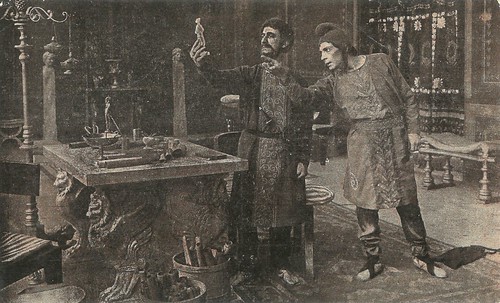
Spanish postcard for Amatller Marca Luna chocolate. Series 8, no. 7. Photo: Palatino Film. Publicity still for Fabiola (Enrico Guazzoni, 1918). Eurota (Augusto Mastripietri) and Fulvio (Amleto Novelli) use a love doll from Corvinus and turn it into a voodoo doll that accuses the Christians of wanting to hurt the empress.

Spanish postcard for Amatller Marca Luna chocolate. Series 8, no. 9. Photo: Palatino Film. Publicity still for Fabiola (Enrico Guazzoni, 1918). The Christians secretly gather in the catacombs. The kneeling woman is Agnese (sig.a Poletti).

Spanish postcard for Amatller Marca Luna chocolate. Series 8, no. 10. Photo: Palatino Film. Publicity still for Fabiola (Enrico Guazzoni, 1918). Blackmailed by Fulvio (Amleto Novelli) and Eurota (Augusto Mastripietri), Quintinus leads them to the Christian girl Agnese (sig.a Poletti), whom Fulvio secretly loves.
Fabiola was one of a series of historical epics for which the Italian film industry became famous during the silent era. It is s typical of the Roman and Christian epics directed by director Enrico Guazzoni during his silent film period.
A Cinema History: "It is an interesting example of early Christian cinematographic proselytism. It is not very accurate from an hagiographic point of view because it brings together saints having lived at different times. The historical background of the persecutions against Christians at the beginning of the second century under Emperors Maximilian and Diocletian is correct, and it is at this time that Pancras and Agnes were killed. The way in which Sebastian and Cecilia are killed is also correct, but it happened in reality several years earlier. Finally concerning the title character of Fabiola, she lived several years later and her life does not correspond to what is shown in the film."
Fabiola mostly follows a chronological approach, with cross-cutting between the actions of various characters. Flashbacks are used to show what certain characters are thinking about. While Guazzoni only uses a static camera, editing is very dynamic with well-composed shots and frequent changes between long shots, medium shots and close ups. The indoor and outdoor sets are very varied and convincing.
The action is also very varied ranging from intimate and peaceful scenes, to violent crowd and circus scenes complete with wild beasts. Lighting is very effective, notably for the final baptism scene with the light coming down from the sky. Acting is mostly quite natural for the time, except a bit of over-acting when the saints are touched by heavenly grace.
In 1949, the novel was turned into a lavish Franco-Italian sound film version, Fabiola (1949), directed by Alessandro Blasetti and starring Michèle Morgan as Fabiola and Henri Vidal as Rhual, a gallic gladiator. The film was an international box office hit, but bears little resemblance to its ostensible source.
A third, Peplum version called La Rivolta degli schiavi/The Revolt of the Slaves (Nunzio Malasomma, 1960), starred American actress Rhonda Fleming, Dario Moreno and Ettore Manni. The supporting cast is impressive with Gino Cervi, Fernando Rey and Serge Gainsbourg. This version takes more elements from the novel than the second, such as including both St. Agnes and St. Sebastian, but strays from the novel in many ways.
The postcards in this post were produced in Spain for the chocolate manufacturer Amatller Marca Luna.
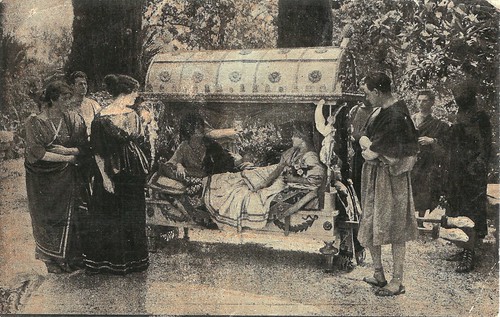
Spanish postcard for Amatller Marca Luna chocolate. Series 8, no. 8. Photo: Palatino Film. Publicity still for Fabiola (Enrico Guazzoni, 1918). Fabiola (Elena Sangro) protects her niece Agnese (Signora Poletti) from the persecutions of the Christians in Rome and flees with her to her countryside villa.
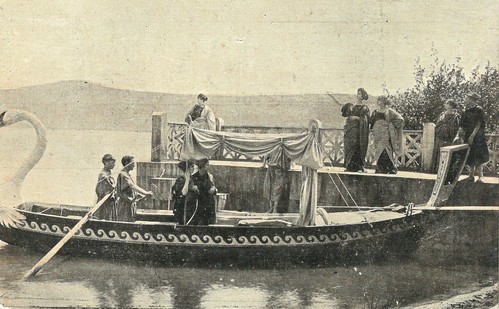
Spanish postcard for Amatller Marca Luna chocolate. Series 8, no. 5. Photo: Palatino Film. Elena Sangro as Fabiola and signora Poletti as her niece Agnese in Fabiola (Enrico Guazzoni, 1918). When the persecutions of the Christians in Rome become too rough, Fabiola takes her niece Agnese to her villa in the countryside.
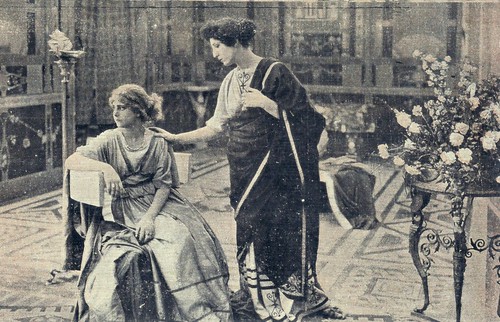
Spanish postcard for Amatller Marca Luna chocolate. Series 8, no. 2. Photo: Palatino Film. Elena Sangro as Fabiola and signora Poletti as her niece Agnese in Fabiola (Enrico Guazzoni, 1918). Fabiola implores her niece Agnese to give up her religion to save her life. NB the table on the right is copied from a Roman original.
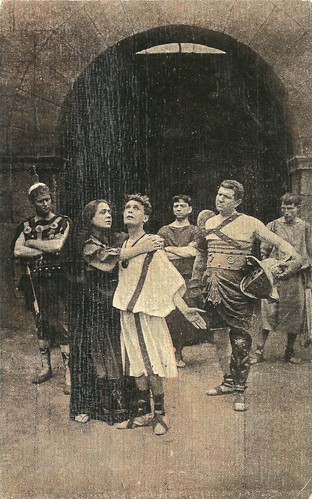
Spanish postcard for Amatller Marca Luna chocolate. Series 8, no. 17. Photo: Palatino Film. Publicity still for Fabiola (Enrico Guazzoni, 1918). Pancrazio and his mother are about to be thrown to the lions.
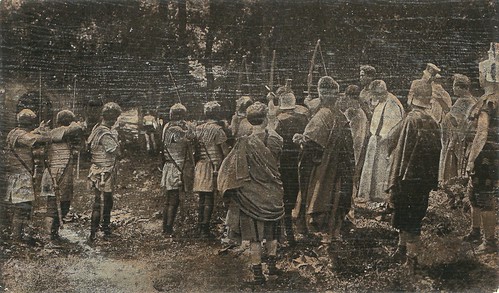
Spanish postcard for Amatller Marca Luna chocolate. Series 8, no. 13. Photo: Palatino Film. Publicity still for Fabiola (Enrico Guazzoni, 1918). The execution of (Saint) Sebastian (Livio Pavanelli).
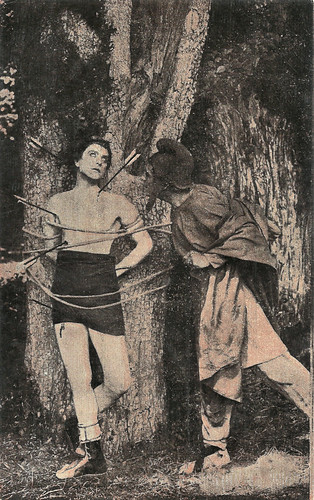
Spanish postcard for Amatller Marca Luna chocolate. Series 8, no. 16. Photo: Palatino Film. Livio Pavanelli as St. Sebastiano and Amleto Novelli as Fulvio in Fabiola (Enrico Guazzoni, 1918).

Spanish postcard for Amatller Marca Luna chocolate. Series 8, no. 18. Photo: Palatino Film. Livio Pavanelli as St. Sebastiano and signora Poletti as Sta. Agnese in Fabiola (Enrico Guazzoni, 1918). While contemplating the supreme light of paganism against Christianism, human reason can only recognise the triumph of the new religion.
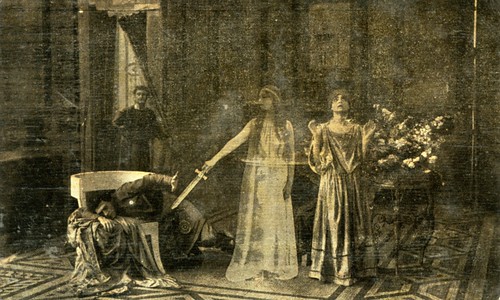
Spanish postcard for Amatller Marca Luna chocolate. Courtesy Cineteca di Bologna
The magnificent Alma-Tadema exhibition that premiered at the Fries Museum in the Netherlands and now still can be seen at the Österreichische Galerie Belvedere in Vienna, will open on 5 July at the Leighton House Museum in London. On 20 and 21 October, there will also be a symposium in London on Lawrence Alma-Tadema between art and cinema.
Sources: A Cinema History, Wikipedia and IMDb.

Spanish postcard for Amatller Marca Luna chocolate. Series 8, no. 1. Photo: Palatino Film. Elena Sangro as Fabiola in Fabiola (Enrico Guazzoni, 1918). When her servant accidentally hurts her with a hairpin, the rich and cruel aristocrat Fabiola hurts her slave with a sharp weapon Roman ladies used to have for these matters. This is from the opening scene of the film.

Spanish postcard for Amatller Marca Luna chocolate. Series 8, no. 3. Photo: Palatino Film. Publicity still for Fabiola (Enrico Guazzoni, 1918). Agnese (sig.a Poletti) tends to the wound of Syrta, afflicted by Fabiola's stiletto.

Spanish postcard for Amatller Marca Luna chocolate. Series 8, no. 6. Photo: Palatino Film. Publicity still for Fabiola (Enrico Guazzoni, 1918). Fulvio remembers how his sister Syra was sold as a slave when she was discovered to be a Christian. He discovers she is in the household of Fabiola.

Spanish postcard for Amatller Marca Luna chocolate. Series 8, no. 14. Photo: Palatino Film. Livio Pavanelli as St. Sebastiano in Fabiola (Enrico Guazzoni, 1918), hosting the blind Cecilia on request of the young Pancrazio.

Spanish postcard for Amatller Marca Luna chocolate. Series 8, no. 12. Photo: Palatino Film. Publicity still for Fabiola (Enrico Guazzoni, 1918). Sebastiano (Livio Pavanelli) chases the intruder Fulvio (Amleto Novelli) from Agnese's house.
The Rise of Christianity
The Italian historical film Fabiola (Enrico Guazzoni, 1918) stars Elena Sangro as Fabiola, Augusto Mastripietri as Eurota, Amleto Novelli as Fulvio, and Livio Pavanelli as San Sebastiano. The secondary role of Quadrato was played by the famous 'forzuto' Bruto Castellani, very popular at the time as the strongman Ursus from Quo vadis? (Enrico Guazzoni, 1913).
The Palatino Film production is an adaptation of the 1854 novel Fabiola by Cardinal Nicholas Patrick Wiseman. The story is set in Rome in the early 4th century AD, during the time of the persecution of Christians under the Roman Emperor Diocletian.
The heroine of both book and film is Fabiola, a young beauty from a noble Roman family. She is spoiled by her father Fabius, who cannot deny her anything. Fabiola seems to have everything, including a superior education in the philosophers, yet under the surface, she is not content with her life.
One day, in a fit of rage, she attacks and wounds her slave girl Syra, who is secretly a Christian. The proud, spoiled Roman girl is humbled by Syra's humility, maturity and devotion to her in this situation, and a slow transformation begins, which finally culminates in her conversion to Christianity, brought on by her own cousin Agnes, whom she adores and dotes on.
Another thread of the novel deals with the young boy Pancratius (in the film called Pancrazio), a pious Christian and son of a martyr, who is himself preparing for martyrdom. Pancratius' nemesis is Corvinus, a bullying schoolmate who is irritated by the young Christian's saintliness. He does everything to bring him and the Christian community of the catacombs of Rome down. This includes the orchestrating of the lynching of their former teacher Cassianus, who is secretly Christian. Yet Pancratius shows his enemy the meaning of Christian forgiveness when he saves his life shortly after Corvinus had Cassianus killed.
Another major villain in the book is the enigmatic Fulvius (in the film called Fulvio), an apparently rich young man from the East who soon reveals himself to be a hunter of Christians who turns them in to the authorities for money. His aim on the one hand is to gain the hand of either Fabiola or Agnes, and on the other hand, to uproot the Christian community in Rome.
After some dramatic events that reveal his surprising connections to Syra, who is his long-lost younger sister Myriam, Fulvius rejects his evil ways, converts to Christianity and becomes a hermit. The story also weaves a number of martyrdom accounts and legends of real-life Christian saints into the fictitious story. These include St. Agnes and St. Sebastian (Sebastiano in the film).

Spanish postcard for Amatller Marca Luna chocolate. Series 8, no. 11. Photo: Palatino Film. Publicity still for Fabiola (Enrico Guazzoni, 1918). Head of the Imperial Guards Sebastiano (Livio Pavanelli) and his aid, the strong Quadrato (Bruto Castellani), have thrown the intruder Fulvio (Amleto Novelli) out, when he wanted to assault Agnese.

Spanish postcard for Amatller Marca Luna chocolate. Series 8, no. 4. Photo: Palatino Film. Publicity still for Fabiola (Enrico Guazzoni, 1918).In the presence of the Roman governor and his son Corvinus, Fulvio (Amleto Novelli) dares the secretly Christian Quintinus to pay tribute to the Roman gods.

Spanish postcard for Amatller Marca Luna chocolate. Series 8, no. 7. Photo: Palatino Film. Publicity still for Fabiola (Enrico Guazzoni, 1918). Eurota (Augusto Mastripietri) and Fulvio (Amleto Novelli) use a love doll from Corvinus and turn it into a voodoo doll that accuses the Christians of wanting to hurt the empress.

Spanish postcard for Amatller Marca Luna chocolate. Series 8, no. 9. Photo: Palatino Film. Publicity still for Fabiola (Enrico Guazzoni, 1918). The Christians secretly gather in the catacombs. The kneeling woman is Agnese (sig.a Poletti).

Spanish postcard for Amatller Marca Luna chocolate. Series 8, no. 10. Photo: Palatino Film. Publicity still for Fabiola (Enrico Guazzoni, 1918). Blackmailed by Fulvio (Amleto Novelli) and Eurota (Augusto Mastripietri), Quintinus leads them to the Christian girl Agnese (sig.a Poletti), whom Fulvio secretly loves.
Violent crowd and circus scenes complete with wild beasts
Fabiola was one of a series of historical epics for which the Italian film industry became famous during the silent era. It is s typical of the Roman and Christian epics directed by director Enrico Guazzoni during his silent film period.
A Cinema History: "It is an interesting example of early Christian cinematographic proselytism. It is not very accurate from an hagiographic point of view because it brings together saints having lived at different times. The historical background of the persecutions against Christians at the beginning of the second century under Emperors Maximilian and Diocletian is correct, and it is at this time that Pancras and Agnes were killed. The way in which Sebastian and Cecilia are killed is also correct, but it happened in reality several years earlier. Finally concerning the title character of Fabiola, she lived several years later and her life does not correspond to what is shown in the film."
Fabiola mostly follows a chronological approach, with cross-cutting between the actions of various characters. Flashbacks are used to show what certain characters are thinking about. While Guazzoni only uses a static camera, editing is very dynamic with well-composed shots and frequent changes between long shots, medium shots and close ups. The indoor and outdoor sets are very varied and convincing.
The action is also very varied ranging from intimate and peaceful scenes, to violent crowd and circus scenes complete with wild beasts. Lighting is very effective, notably for the final baptism scene with the light coming down from the sky. Acting is mostly quite natural for the time, except a bit of over-acting when the saints are touched by heavenly grace.
In 1949, the novel was turned into a lavish Franco-Italian sound film version, Fabiola (1949), directed by Alessandro Blasetti and starring Michèle Morgan as Fabiola and Henri Vidal as Rhual, a gallic gladiator. The film was an international box office hit, but bears little resemblance to its ostensible source.
A third, Peplum version called La Rivolta degli schiavi/The Revolt of the Slaves (Nunzio Malasomma, 1960), starred American actress Rhonda Fleming, Dario Moreno and Ettore Manni. The supporting cast is impressive with Gino Cervi, Fernando Rey and Serge Gainsbourg. This version takes more elements from the novel than the second, such as including both St. Agnes and St. Sebastian, but strays from the novel in many ways.
The postcards in this post were produced in Spain for the chocolate manufacturer Amatller Marca Luna.

Spanish postcard for Amatller Marca Luna chocolate. Series 8, no. 8. Photo: Palatino Film. Publicity still for Fabiola (Enrico Guazzoni, 1918). Fabiola (Elena Sangro) protects her niece Agnese (Signora Poletti) from the persecutions of the Christians in Rome and flees with her to her countryside villa.

Spanish postcard for Amatller Marca Luna chocolate. Series 8, no. 5. Photo: Palatino Film. Elena Sangro as Fabiola and signora Poletti as her niece Agnese in Fabiola (Enrico Guazzoni, 1918). When the persecutions of the Christians in Rome become too rough, Fabiola takes her niece Agnese to her villa in the countryside.

Spanish postcard for Amatller Marca Luna chocolate. Series 8, no. 2. Photo: Palatino Film. Elena Sangro as Fabiola and signora Poletti as her niece Agnese in Fabiola (Enrico Guazzoni, 1918). Fabiola implores her niece Agnese to give up her religion to save her life. NB the table on the right is copied from a Roman original.

Spanish postcard for Amatller Marca Luna chocolate. Series 8, no. 17. Photo: Palatino Film. Publicity still for Fabiola (Enrico Guazzoni, 1918). Pancrazio and his mother are about to be thrown to the lions.

Spanish postcard for Amatller Marca Luna chocolate. Series 8, no. 13. Photo: Palatino Film. Publicity still for Fabiola (Enrico Guazzoni, 1918). The execution of (Saint) Sebastian (Livio Pavanelli).

Spanish postcard for Amatller Marca Luna chocolate. Series 8, no. 16. Photo: Palatino Film. Livio Pavanelli as St. Sebastiano and Amleto Novelli as Fulvio in Fabiola (Enrico Guazzoni, 1918).

Spanish postcard for Amatller Marca Luna chocolate. Series 8, no. 18. Photo: Palatino Film. Livio Pavanelli as St. Sebastiano and signora Poletti as Sta. Agnese in Fabiola (Enrico Guazzoni, 1918). While contemplating the supreme light of paganism against Christianism, human reason can only recognise the triumph of the new religion.

Spanish postcard for Amatller Marca Luna chocolate. Courtesy Cineteca di Bologna
The magnificent Alma-Tadema exhibition that premiered at the Fries Museum in the Netherlands and now still can be seen at the Österreichische Galerie Belvedere in Vienna, will open on 5 July at the Leighton House Museum in London. On 20 and 21 October, there will also be a symposium in London on Lawrence Alma-Tadema between art and cinema.
Sources: A Cinema History, Wikipedia and IMDb.
No comments:
Post a Comment